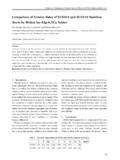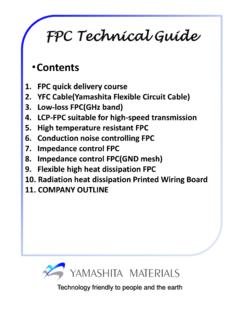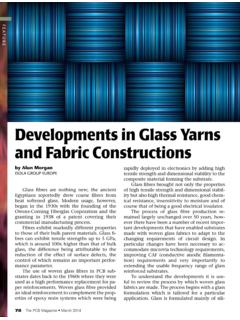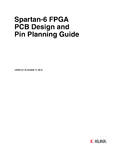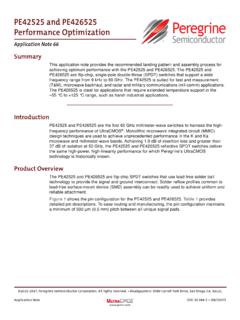Transcription of Low Warpage Coreless Substrate for IC Packages
1 55 Kurashina et al.: Low Warpage Coreless Substrate (1/8)1. BackgroundWith a continuous enhancement of performance and feature downsizing of electronic products, the use of Ball grid array (BGA) Packages is spreading rapidly as elec-tronic products because of their advantage in higher pin counts. Moreover, in keeping with the IC upsizing pace, even more fine BGAs are necessar y, and as a result, the development of high reliability assembly processes for fine-pitch ICs had become essential. We believe that one of the important factors for the BGA performance is dielec-tric materials, which include ceramics[1] and organic materials.[2 4] We have been continuously developing buildup BGA substrates making use of organic materi-als[5] that are more advantageous over ceramics because of their low cost and microfabrication Substrate consists of core layers reinforced by glass cloths and buildup layers consisting of resin films.
2 Generally, the thickness of core layers is in a range of 200 800 m. Therefore, via plated through holes (PTH), which penetrates through core layers, is needed for interconnec-tion. The minimum limit of PTH pitch is estimated to be 200 m, but solder bump pitch for ASICs is expected to become around 100 m.[6] Therefore, the development of finer interconnection technologies for organic BGA sub-strates is highly essential. Whereas vias of buildup layers can be made by a laser process, which is suitable for microfabrication and the minimum via size is estimated to be 30 m. Therefore, high density wiring can be realized by the adoption of Coreless Substrate , which doesn t include core layers.[7, 8]The comparison of properties between Coreless and buildup Substrate is shown in Fig.
3 1. In general, the adop-tion of Coreless substrates for IC Packages has three advantages, including high wiring design flexibility owing to fine via pitch, power source improvement because of low impedance, and large signal integrity. However, core-[Technical Paper]Low Warpage Coreless Substrate for IC PackagesMamoru Kurashina*, Daisuke Mizutani*, Masateru Koide**, Manabu Watanabe**, Kenji Fukuzono**, Nobutaka Itoh**, and Hitoshi Suzuki**Fujitsu Laboratories Ltd., 10-1 Morinosato-Wakamiya, Atsugi-shi, Kanagawa 243-0197, Japan**Fujitsu Advanced Technology, Ltd., 1-1, Kamikodanaka 4-chome, Nakahara-ku, Kawasaki-shi, Kanagawa 211-8588, Japan**Fujitsu Interconnect Technologies, Ltd., 36, Kitaowaribe, Ooaza, Nagano 381-8501, Japan(Received July 26, 2012; accepted October 15, 2012)AbstractCoreless Substrate is excellent for fine patterning, small via pitches, and transmission property, and it is a promising IC packaging method for the next generation.
4 Warpage of Coreless Substrate is generally large compared to the other types of IC packaging substrates because of inadequate rigidity, so the most important problem for the application of Coreless substrates for high -end BGAs is Warpage reduction during a reflow process. So far, only a limited number of reports have been focused on Coreless substrates for large size IC Packages . Moreover, ver y few examples have discussed Substrate layer structural designs for Warpage reduction and reliability improvement in IC assembly processes. In our study, we focused on the development of Coreless substrates for large size ICs. To achieve our goal, we adopted the following development procedure. First, we designed analytical models with different layer structures composed of two kinds of insulating materials and estimated the effective layer structures for Warpage reduction by numerical analysis.
5 Next, we prepared the real Coreless substrates with the same structure as the analytical models and evaluated their actual thermal behavior. Finally, we investigated the thermal stress reliability of IC mounted substrates . As results of these examinations, we successfully developed low Warpage and high reliable Coreless Substrate by introducing high rigidity materials only in the external layers of the : Coreless Substrate , Low Warpage , IC mounted reliability, Layer structure, Prepreg56 Transactions of The Japan Institute of Electronics Packaging Vol. 5, No. 1, 2012less substrates include no core layers with high rigidity, thermal Warpage of Coreless substrates becomes larger than that of the buildup substrates . As a result, large ICs cannot be mounted on Coreless substrates . The reliability issue due to large Warpage has prevented the widespread use of Coreless substrates including high end use.
6 To date, Coreless substrates have been used in limited applications such as small size of CSPs. In this study, we aim to develop Coreless substrates with ver y low Warpage below 100 m for a BGA bump pitch of 1 mm, on which large size of ICs greater than 20 mm squares can be mounted. Then we performed additional verification experiments and added the assumed mechanisms for the results to our previous report.[9]2. Experimental Preparation of Coreless substratesFirst, we researched the Warpage improvement methods of Coreless substrates . To improve the rigidity of Coreless Substrate , the use of prepregs as a dielectric material has been recently reported.[10] Prepreg is adhesion resin sheet that is reinforced by glass cloths, and this material is widely used as a bonding sheet. However, prepregs could cause skew in differential wirings for high -speed transmis-sions due to the presence of glass cloth, and an explana-tion figure of skew generation mechanism is shown in Fig.
7 2. Therefore, coexisting of low Warpage and excellent transmission property is ver y important and it can be achieved by using a minimum number of prepregs. In this study, we examined to reduce Warpage by the application of two kinds of dielectric materials, which are prepreg and resin. To control the Warpage from the moment effect, we arranged prepregs in external layers. Moreover, for the skewless transmission, we arranged resins in internal lay-ers. Thus, we propose Coreless structures with external prepregs and internal resins to achieve both we prepared four kinds of Coreless substrates with different layer structures. Figure 3 describes the wiring layer structure of the prepared Coreless Substrate . In this figure, white area indicates the wiring layer and the other area is insulating layer.
8 The Cu ratio of seven layers was roughly adjusted to be equivalent for Warpage reduction. The Coreless substrates had an area of mm squares and thickness of mm. We also included IC bumps and daisy-chain patterns for evaluation of IC and BGA bump interconnection reliability with 20 mm squares ICs. Figure 4 shows the external appearance of Coreless 1 Comparison of properties between Coreless and buildup 2 Skew problem of differential pair lines in 3 Wiring layer structure of prepared Coreless 4 Appearance of Coreless et al.: Low Warpage Coreless Substrate (3/8)The layer structures of the substrates are shown as fol-lows:All-PP: all prepreg layersOuter-PP: two internal resin layers / four external pre-preg layersInner-PP: two external resin layers / four internal pre-preg layersAll-resin: all resin layersThe cross-sectional images of substrates and schematic figure of layer structures are shown in Fig.
9 5 and Fig. 6. Here, only the layer composition was changed by different combination of two buildup materials named GX-13 (resin) and GX13-GC (prepreg, GX-13 resin impregnated with glass cloths) commercialized by Ajinomoto Fine-Techno Co., Evaluation methods Numerical analysis Laminated shell models were created with great care to describe the wiring and vias of all layers of substrates . They were converted from EDA-CAD by the BoardWARP system, which we previously developed. With this system, we can obtain precise mesh data from original CAD data. The mechanism of this system has previously been described in detail.[11] This time all the wiring layer images of the CAD and analytical model data were pro-duced by our method. The analytical parameters were mesh pitch = 50 m, total number of elements = 810,000, and computing time = 50 h.
10 Images of the analytical model are shown in Fig. 7. In this figure, white area indicates the wiring layer and the other area is insulating layer. By com-paring both, we confirmed CAD data were faithfully executed thermal Warpage analyses with the general structural analysis software as an analytical solver. This time, we performed viscoelastic analyses for accurate prediction. The theor y has been described in detail to various technological theses.[12] Here, the visco-elastic theor y used for viscoelastic analysis is concisely described. In viscoelastic analysis, it is necessar y to use the relaxation modulus that is the function of time (t). The viscoelastic equation, which is the relation between the stress and the deformation , can be expressed below with G(t). ()()()tGtdddt= (1)The thermal viscoelastic equation can be expressed below with relaxation modulus G(e,T0).




